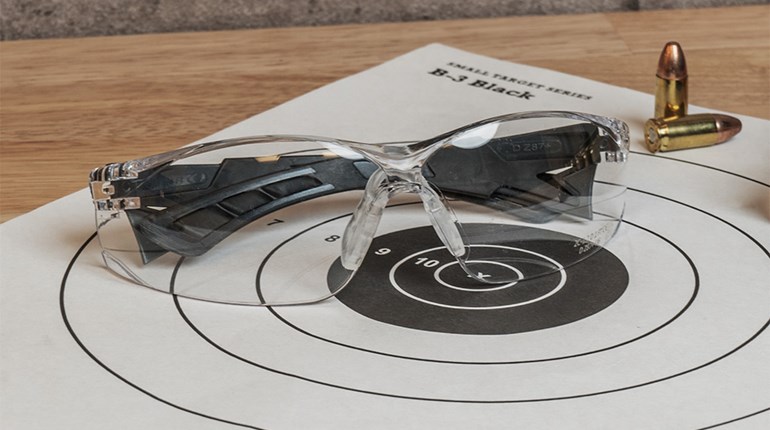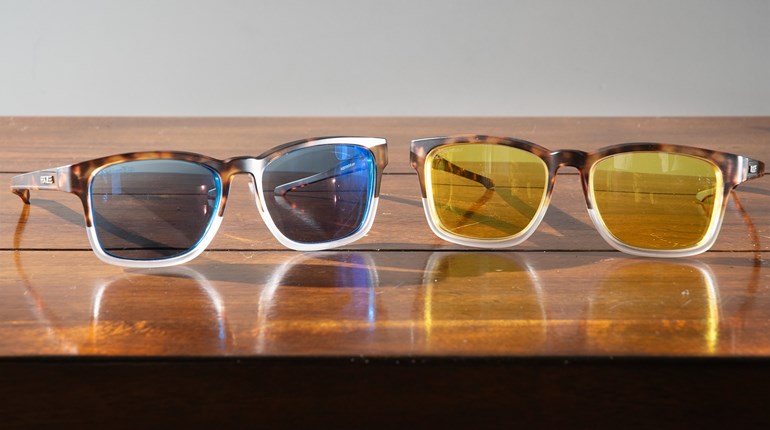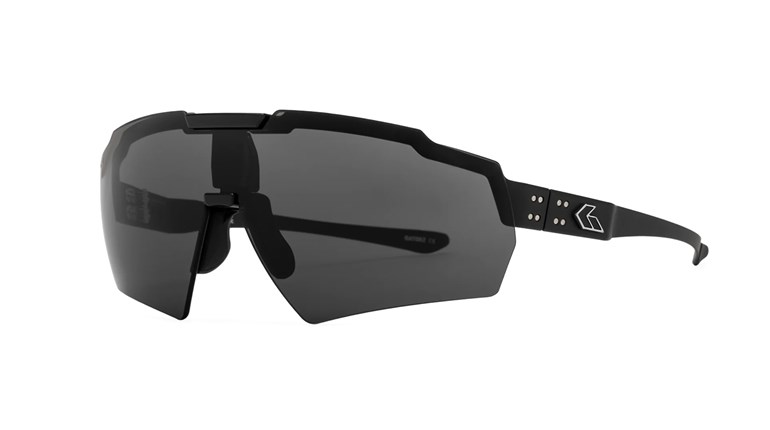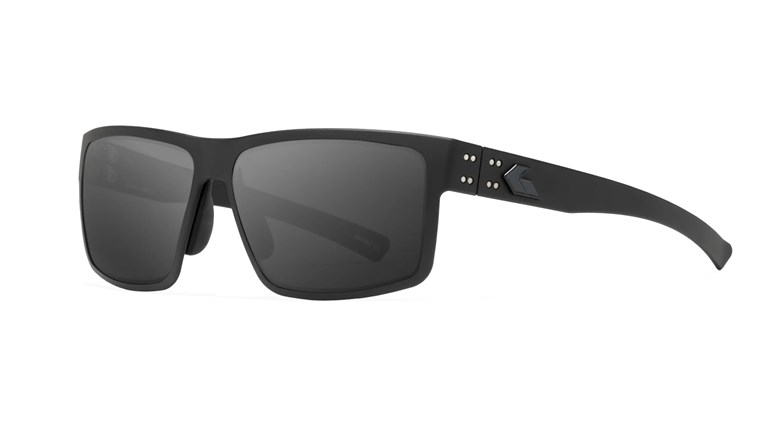
It’s like this manic, boring, crazy mantra: “Eyes and ears!” Yeah, we know it’s manic, boring, etc. The problem you face when you’re around serious shooters, though, is that we just don’t care how boring it is. If you haven’t had a close call, you will. If you’ve had yours, we hope you survived with binocularity intact. And if you’ve got a lick of sense, it rightly gave you the shakes.
If you’re not quite with us, we’re talking about eye protection (we’ll get to ears down the road). There’s only one rule, which is, “Have some.” And we mean all day, every day, each and every shot. The “why” should be obvious: Eye injury or vision loss won’t just affect your shooting (duh), so why risk it? “How” is another matter, which brings us to criteria of considerable latitude: “Cheap or expensive?”
While there are lots of considerations, there’s a somewhat American default to thinking expensive is automatically better, or—considering the stakes—necessary. A lot of advertising money is spent to confirm this suspicion. The correct choice for every individual shooter requires good data, however, and it starts with materials.

Forty years ago, this was an arguable question; now, not so much—polycarbonate is best. Much lighter and easier to shape than glass, it is also far stronger (up to 10 times) than most other plastic and glass alternatives. Another advantage is UV opaqueness (99-plus percent)—not a trivial concern considering the link between sunlight exposure and cataracts.
If you lean toward the hot-rod end of the eyewear scale, the following is probably not a concern. But at the lower end, pay attention: An arcane specification from the American National Standards Institute (ANSI) should be on your radar.
This standard—known as Z87—governs the materials used in protective eyewear, and measures the punishment they’ll take. The good news is that it’s hard to find any eyewear anymore that doesn’t reach the lower end of the standard (which is good protection), but that’s not where you want to be for shooting glasses. Long story short—anything you choose for shooting should have a “high impact” rating, and be physically encoded with “Z87+” somewhere on the glasses and frames. (Frames must be able to withstand the same punishment as lenses because any failure there will allow a projectile to reach the eye.)
Another factor to be considered is coatings. Polycarbonate is actually quite soft at the micro level, and hence easily scratched (paradoxically, this is what gives it such good protective qualities—it absorbs and distributes energy through its structure extremely efficiently). A hardness coating is pretty much essential, or normal handling would render your specs infuriatingly scratched in short order. Other surface treatments include polarizing and mirroring: The former helps some shooters tremendously in terms of clarity by rerouting glare-producing reflected light away from the eye, while the latter is mainly cosmetic.
So what’s a conscientious gentleman or lady to do? Do you really need a $150 to $400 pair of shooting glasses? We answer in the form of our own story, and will let you draw your own conclusions.
Other than misses, the only thing we generated more prolifically over the years was lost/broken/hopelessly scratched sunglasses. If you research carefully, in fact, you’ll discover the deeply underappreciated Winn’s Corollary: The more expensive the sunglasses, the sooner they are rendered useless.
We eventually reduced good and inexpensive to a science, with good success (a favorite example here). They are Z87, high impact (“+”), offer a selection of colors that have worked across the board—indoors or out, bright sunshine or overcast—have plenty of “wrap” for side protection, and feature a vastly misunderstood tilt-adjustable temple that kept the eye pit cool in summer (lens tilted up), yet held out condensing breath in the winter (tilted down against the cheek). Also, you need no infuriating, fingerprint-producing lens swaps: Just change the whole kit.
The expensive color, our favorite of course, was also the most versatile—vermillion (pinkish, to us flyover country types). They cost NINE BUCKS. We bought ‘em a half a dozen at a time, and loaned them, even gave them, in a profligate fashion. Big match equaled a fresh pair. A scratch equaled a fresh pair. A little over-spray at SCSA? Sit on ‘em? You guessed it: Fresh pair.
And it was a great solution, for a couple of decades in fact. Then, one Christmas came a box emblazoned with that dreaded flattened “O.” For training and practice, you’ll obviously use your specs, as every range we know of quite sensibly requires it.One thing led to another, and perhaps only the endgame is of interest. We’re now shooting with a set of Oakley “Tombstones.” Simply put, it’s hard to imagine using anything else.
For openers, the lens swapping methodology is dynamite. Unlike our original M1s (which we loved optically, but the cursing from our last lens change may still be echoing), a single trigger mechanism at each temple releases the still-foldable bows, which are swapped in toto to the alternate lenses. You’ll have to be notably clumsier than we are to struggle at all. And seriously: No fingerprints.
PRIZM™ lens technology is next, and it really is astonishing. We’re on the ragged edge of needing correction for shooting (yes, fortunate indeed, given our proximity to geezerhood). But the combination of filtering (UVA, UVB and 400nm violet-blue) and rimless, 120-degree view may have literally put this off for years. Truly, they’re that much of an improvement.
Oakley used the input of high-end military shooters to gather specs for the design, and we think it shows. Whether it’s the science in things like color-tuned contrast that helps differentiate targets and backgrounds, or their special Plutonite™ polycarb, we can’t say from our own knowledge. What we can say merely gets us back to where we started: You’ll only get us back to something else kicking and screaming.
On net, both the budget and premium solutions have their benefits. We’d rather shoot in the Oakleys, but the thought of losing them brings tears. Our cheapies? We keep them as backups. You also never know when a spectator will be unprepared, especially a child spectator. You’ll get way more than a $9 smile when you tell that wee watcher to just keep those real shooting glasses, too.
How this becomes a Carry Life concern may seem a little circuitous, but here it is. For training and practice, you’ll obviously use your specs, as every range we know of quite sensibly requires it. And you should be doing it no matter what as a prudent, responsible shooter.
But what about a real shooting situation? Think about it: All your practice is done with the eyes protected from concussion and particulates that result from powder combustion (if you haven’t been slagged this way, you will be—the back end of some pistols is astonishingly porous). It’ll be a dangerous distraction at best. At worst, well, use your imagination.
As you age, you may wear glasses all the time anyway. The fix for this concern then takes care of itself. But if you’re lucky enough not to be needing glasses when routinely out and about, think carefully about what that unhoped-for assault and subsequent defensive scenario might mean for your eyes. We understand that your actual range eye gear may have some compromises for everyday use, so don’t misconstrue this as a suggestion to accommodate by foregoing your eye protection in practice. Always, always, always protect those peepers.
But we are suggesting that the problem deserves some serious thought. The most obvious solution is to get in the habit of always wearing some form of eye protection. Like so many other aspects of the Carry Life (here, for instance), it has other advantages: Shooting side effects aren’t the only way to damage your eyes, and they’re the only pair you have.
Now Carry on.


































